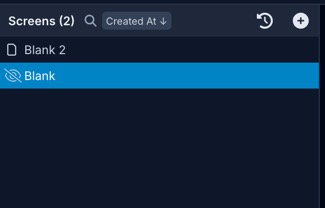Screen
Screens are the foundation of your app's user interface (UI). All apps have one or more Screens, and each Screen can have their own Styling, Variables, Functions, and more.
All the other available components, such as View, Button, and Text are nested inside a Screen in the component tree as child components.
Screens can be added to Stack and Tab navigators to organize different parts of your app. You can also navigate between Screens using the Navigate Action from an interactive component like a Button, Link, or Pressable.
Adding a Screen to your app
To add a Screen to the app:
- Click the
+button in the top-right of the Screens list. - Select Add Blank to add an empty Screen to your app or Add Example Screen to open the templates modal to select a pre-built Screen.
Renaming a Screen
A Screen can be renamed by double-clicking it in the Screens list, typing a new name, and then hitting the Enter key.
You can also rename a Screen by going to the Config tab and updating the Name prop.
Disabling/Hiding a Screen
You can prevent a Screen from being included in your exported or published app by clicking the icon to the left of the Screen name in the Screens List.

Style Properties
Style properties allow you to customize the look and feel of the component. Combinations of styles applied to components can be saved as Stylesheets to easily reuse styles throughout your app. Styles can also be set dynamically using Variables. To learn more about all the different styling properties and how they work, take a look at Intro to Styling.
Configuration Properties
Basic
Property | Description |
|---|---|
Name | To alter the name of the screen. The name is reflected in the Screen list at the top left in the builder, used when navigating using custom code, and in the file name of the actual codebase.
Defaults to |
Description | Add an optional description of the Screen. |
Status Bar Color | This will adjust the color of the text (clock...) and icons (battery...) in the operating system's Status Bar to accommodate the background color. Defaults to |
Scrollable | If enabled, screen height will increase as per the content within it and will be scrollable to show the content in the visible area. Disabled by default. |
Advanced
| Property | Description |
|---|---|
| Safe Area View | When enabled, Safe Area is calculated for all sides of the device |
| Top Area View | When enabled, Safe Area is calculated for the top side of the device |
| Bottom Area View | When enabled, Safe Area is calculated for the bottom of the device |
| Left Area View | When enabled, Safe Area is calculated for the left side of the device |
| Right Area View | When enabled, Safe Area is calculated for the right side of the device |
Enabling Safe Area View on a Screen can help display content correctly on devices with notches and UI elements which may overlap the app content. Learn more in the Safe Area doc.
Data Properties
Navigation Params
Navigation parameters allow you to pass data to a Screen when navigating to it.
For instance, if you have a Screen with a List of properties and another Screen that displays a single property's details, you can add a navigation parameter to the details Screen of id. Then you'll be able to pass the list item's id value from the list Screen when you navigate to the details Screen where you can make a request to your API to fetch the details to display.
| Property | Description |
|---|---|
| Parameter Name | Enter a name and click the ✔️ button to add a navigation parameter. |
Deep Linking
Deep Linking is an advanced feature which allows you to open a specific Screen in your app from a website or another app.
In order to access a Screen from a different app, type the provided URL into a web browser. This will only work if you're using the Draftbit Live Preview app or if you export your project
| Property | Description |
|---|---|
| Create Deep Link for this Screen | Enable to create a deep link to the current Screen |
Triggers
| Name | Description |
|---|---|
| On Screen Focus | Runs every time the user navigates to the Screen |
| On Screen Blur | Runs every time the user navigates away from the Screen |
Updated about 1 year ago
